PARP-1 deficiency increases the severity of disease in a mouse model of multiple sclerosis
- PMID: 19628872
- PMCID: PMC2758007
- DOI: 10.1074/jbc.M109.013474
PARP-1 deficiency increases the severity of disease in a mouse model of multiple sclerosis
Abstract
Poly(ADP-ribose) polymerase-1 (PARP-1) has been implicated in the pathogenesis of several central nervous system (CNS) disorders. However, the role of PARP-1 in autoimmune CNS injury remains poorly understood. Therefore, we studied experimental autoimmune encephalomyelitis (EAE), a model for multiple sclerosis in mice with a targeted deletion of PARP-1. We identified inherent physiological abnormalities in the circulating and splenic immune composition between PARP-1(-/-) and wild type (WT) mice. Upon EAE induction, PARP-1(-/-) mice had an earlier onset and developed a more severe EAE compared with WT cohorts. Splenic response was significantly higher in PARP-1(-/-) mice largely because of B cell expansion. Although formation of Th1 and Th17 effector T lymphocytes was unaffected, PARP-1(-/-) mice had significantly earlier CD4+ T lymphocyte and macrophage infiltration into the CNS during EAE. However, we did not detect significant differences in cytokine profiles between PARP-1(-/-) and WT spinal cords at the peak of EAE. Expression analysis of different PARP isozymes in EAE spinal cords showed that PARP-1 was down-regulated in WT mice and that PARP-3 but not PARP-2 was dramatically up-regulated in both PARP-1(-/-) and WT mice, suggesting that these PARP isozymes could have distinct roles in different CNS pathologies. Together, our results indicate that PARP-1 plays an important role in regulating the physiological immune composition and in immune modulation during EAE; our finding identifies a new aspect of immune regulation by PARPs in autoimmune CNS pathology.
Figures
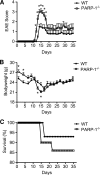
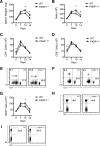
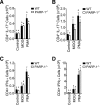

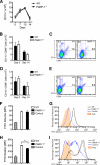
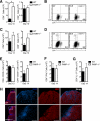
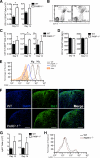
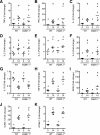

Similar articles
-
Increased expression of phospholipase D1 in the spinal cords of rats with experimental autoimmune encephalomyelitis.Neurosci Lett. 2001 Dec;316(2):95-8. doi: 10.1016/s0304-3940(01)02383-7. Neurosci Lett. 2001. PMID: 11742724
-
CD134 plays a crucial role in the pathogenesis of EAE and is upregulated in the CNS of patients with multiple sclerosis.J Neuroimmunol. 2003 Dec;145(1-2):1-11. doi: 10.1016/j.jneuroim.2003.07.001. J Neuroimmunol. 2003. PMID: 14644025
-
Poly(ADP-ribose) polymerase 2 contributes to neuroinflammation and neurological dysfunction in mouse experimental autoimmune encephalomyelitis.J Neuroinflammation. 2013 Apr 22;10:49. doi: 10.1186/1742-2094-10-49. J Neuroinflammation. 2013. PMID: 23607899 Free PMC article.
-
PARP-1 inhibition prevents CNS migration of dendritic cells during EAE, suppressing the encephalitogenic response and relapse severity.Mult Scler. 2011 Jul;17(7):794-807. doi: 10.1177/1352458511399113. Epub 2011 Feb 22. Mult Scler. 2011. PMID: 21343230
-
The Toll-like Receptor 2 (TLR2)-related Immunopathological Responses in the Multiple Sclerosis and Experimental Autoimmune Encephalomyelitis.Iran J Allergy Asthma Immunol. 2019 Jun 8;18(3):230-250. doi: 10.18502/ijaai.v18i3.1117. Iran J Allergy Asthma Immunol. 2019. PMID: 31522431 Review.
Cited by
-
Association of three SNPs in the PARP-1 gene with Hashimoto's thyroiditis.Hum Genome Var. 2014 Oct 30;1:14016. doi: 10.1038/hgv.2014.16. eCollection 2014. Hum Genome Var. 2014. PMID: 27081507 Free PMC article.
-
Specific and shared biological functions of PARP2 - is PARP2 really a lil' brother of PARP1?Expert Rev Mol Med. 2024 May 3;26:e13. doi: 10.1017/erm.2024.14. Expert Rev Mol Med. 2024. PMID: 38698556 Free PMC article. Review.
-
Therapeutic applications of PARP inhibitors: anticancer therapy and beyond.Mol Aspects Med. 2013 Dec;34(6):1217-56. doi: 10.1016/j.mam.2013.01.006. Epub 2013 Jan 29. Mol Aspects Med. 2013. PMID: 23370117 Free PMC article. Review.
-
PARP2 promotes inflammation in psoriasis by modulating estradiol biosynthesis in keratinocytes.J Mol Med (Berl). 2023 Aug;101(8):987-999. doi: 10.1007/s00109-023-02338-z. Epub 2023 Jun 23. J Mol Med (Berl). 2023. PMID: 37351597 Free PMC article.
-
Modulation of PARP activity by Monomethylarsonous (MMA+3) acid and uranium in mouse thymus.Toxicol Appl Pharmacol. 2021 Jan 15;411:115362. doi: 10.1016/j.taap.2020.115362. Epub 2020 Dec 3. Toxicol Appl Pharmacol. 2021. PMID: 33279514 Free PMC article.
References
-
- Chambon P., Weill J. D., Mandel P. (1963) Biochem. Biophys. Res. Commun. 11, 39–43 - PubMed
-
- Kim M. Y., Zhang T., Kraus W. L. (2005) Genes Dev. 19, 1951–1967 - PubMed
-
- Amé J. C., Spenlehauer C., de Murcia G. (2004) BioEssays 26, 882–893 - PubMed
-
- Moroni F. (2008) Curr. Opin. Pharmacol. 8, 96–103 - PubMed
Publication types
MeSH terms
Substances
Grants and funding
LinkOut - more resources
Full Text Sources
Other Literature Sources
Medical
Molecular Biology Databases
Research Materials
Miscellaneous

